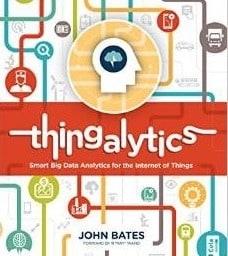
Many organizations today are interested in using real-time analytics and algorithms to seize the opportunities that flow from the Internet of Things (IoT) while simultaneously minimizing threats. Here, RT Insights Editorial Director Suzanne Kattau reviews “Thingalytics: Smart Big Data for the Internet of Things,” a new book that aims to show businesses how to do just that.
“Thingalytics” (a composite of “Things” and “Analytics”) was written by Dr. John Bates, Chief Marketing Officer at Software AG, a provider of Big Data, integration and business process technologies. Institutional Investor named Dr. Bates as one of the “Tech 50” most influential technologists in 2014 and Wall Street and Technology named him as one of the top ten “Innovators of the Decade” in 2013.
Published in March 2015, “Thingalytics: Smart Big Data for the Internet of Things“ delves into the world of analytics and algorithms to show readers how to seize the opportunities buried within the IoT. In the book, Dr. Bates uses real stories gleaned from interviews he conducted with some of the most tech-savvy banks, retailers, soft drink manufacturers and transportation providers.
Combining Internet of Things and Analytics
“Thingalytics is happening now. Market leaders and fast followers are in the midst of this digital transformation,” wrote R “Ray” Wang, founder and Principal Analyst at Constellation Research, Inc., in the book’s foreword. “As organizations transform and create new business models and cultures with digital technologies, a distinct set of winners and losers will emerge.”
Wang continued, stating how “Digital Darwinism is unkind to those who wait” and how “this brave new world of smarter machines, and the humans who engage them, will change every industry and every market segment.” According to Wang, today’s digital divide serves as a precursor to the impact of Thingalytics.
“The top three competitors in every mature market segment control 43 to 71 percent of the market share and 53 to 77 percent of the profits,” wrote Wang. “Thingalytics represents this next evolution of digital disruption. Savvy leaders should take note on how to disrupt first or face disruption.”
Introduction to Thingalytics
So, what is Thingalytics? “Thingalytics is the use of real-time analytics and algorithms to make sense of the fast, Big Data arising from the Internet of Things,” wrote Dr. Bates in the introduction to his book. “The Internet of Things is much more important and transformative than that. In fact, it is going to change everything—just as the original Internet did.”
The IoT includes self-driving cars, smart phones, wearable devices including smart watches, and head-up-display glasses. He continued, stating:
At the grassroots level, smart Things come to life by using sensors and actuators, which are then attached to networks, thereby enabling us to monitor and control them remotely. This new universe, comprised of these networked smart objects or “Things” is called the “Internet of Things.”
The Internet of Things is about digitizing everything in the real world and integrating it into the Internet. In some cases this technology is new; for example, washing machines that we can control remotely and that can message us when a wash cycle is complete and alert us when they are about to break down. In other cases it has been around for a while; for example, digital data from the stock market that we can stream, enabling us to place our trades electronically. The Internet of Things brings together this existing digital streaming data (stock market, news, weather) with social media (Twitter, Facebook), along with new sources of data from real-world objects.
Real world objects are “digitized” by capturing their status using sensors. Different types of sensors can track myriad factors such as temperature, location, pressure and speed. Upload those sensor readings onto the Internet, and any appropriately authorized app can consume, analyze and respond to them. Put an application programming interface (API) on the object, connected to onboard actuators, and suddenly the app can control the object remotely.
Thingalytics and RT Insights
According to Dr. Bates, the idea of the IoT has come to the fore as technology has become more capable. “As the costs of sensors and connectivity drop, viable use-cases are increasingly realized,” he wrote. “Put simply, the Internet of Things represents an emerging reality where everyday objects and devices are connected to the Internet, most likely wirelessly, and can communicate with one another at some intelligent level.”
Not only can these devices now communicate with each other, but, increasingly, applications can monitor and analyze the behavior of these devices, thereby providing enterprises near real-time insights into their business processes. This is what Dr. Bates discusses in Thingalytics which is perfectly aligned with our coverage on RT Insights.com.
Available on Amazon
Thingalytics is available on Amazon in paperback or Kindle versions. For more chapter videos and information about Thingalytics, visit the book’s website.
Chapter 1: It’s All About Me (video featuring author Dr. John Bates):
Thingalytics book cover image courtesy of Amazon.com
Thingalytics video courtesy of the book’s website.
Want more? Check out our most-read content:
Frontiers in Artificial Intelligence for the IoT: White Paper
Research from Gartner: Real-Time Analytics with the Internet of Things
How Real-Time Railroad Data Keeps Trains Running
Operational Analytics: Five Tips for Better Decisions
Why Gateways and Controllers Are Critical for IoT Architecture
Liked this article? Share it with your colleagues!




























